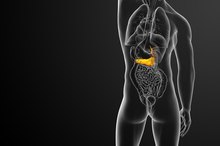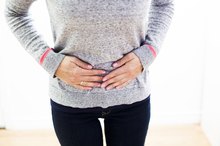Stomach aches and back pain can make you feel terrible, particularly when they occur together. As they are both common problems, when abdominal and back pain occur at the same time, it may be just a coincidence. But several medical conditions can cause both symptoms. Because there are many different organs in your abdomen, determining the exact cause of your pain can be difficult. However, many of the conditions are serious, so it is best to see a doctor if you have both symptoms.
If you are experiencing serious medical symptoms, seek emergency treatment immediately.
Acute Cholecystitis
Acute inflammation of the gall bladder -- called acute cholecystitis -- is a common cause of pain in the upper abdomen, which may extend through to the back or to the right shoulder blade. The abdominal pain is primarily on the right side, where the gall bladder is located. It is usually sharp and severe, and becomes worse when taking a deep breath. Nausea and vomiting often accompany the pain, and about one-third of people with acute cholecystitis develop a fever, according to “Merck Manual.” Acute cholecystitis is generally caused by gallstones and usually resolves on its own in about a week 6. The gall bladder is often removed when people have repeated attacks of acute cholecystitis.
- Acute inflammation of the gall bladder -- called acute cholecystitis -- is a common cause of pain in the upper abdomen, which may extend through to the back or to the right shoulder blade.
Acute Pancreatitis
Causes of Lower Left-Side Abdominal Pain
Learn More
Inflammation of the pancreas causes sharp pain deep within the upper abdomen, which goes through to the back in about 50 percent of people, according to “Merck Manual.” The pain tends to improve with leaning forward or curling up into a ball and worsens with coughing, deep breaths or vigorous body movements. Nausea or vomiting often accompany the pain. A person with acute pancreatitis usually feels sick, may have a fever and can have trouble breathing. When severe, acute pancreatitis can cause inflammation in other areas of the body, leading to heart, lung or kidney failure. Acute pancreatitis is most frequently due to gallstones, but excessive alcohol intake is another common cause. Treatment in the hospital is usually required.
- Inflammation of the pancreas causes sharp pain deep within the upper abdomen, which goes through to the back in about 50 percent of people, according to “Merck Manual.” A person with acute pancreatitis usually feels sick, may have a fever and can have trouble breathing.
Peptic Ulcers
Peptic ulcers are open sores in the stomach or small intestine. Peptic ulcers can cause both abdominal and back pain. The pain is typically worse between meals, when the stomach or intestines are relatively empty. Nausea and vomiting may accompany the pain. Peptic ulcers may also bleed, causing a person to vomit up blood or have black, tar-like bowel movements. The most common cause of peptic ulcers is an infection with a bacteria called Helicobacter pylori. Stress and diet may also play a role in causing peptic ulcers. Nowadays peptic ulcers are usually treated with medications, although emergency surgery may be required if severe bleeding occurs.
- Peptic ulcers are open sores in the stomach or small intestine.
- The pain is typically worse between meals, when the stomach or intestines are relatively empty.
Kidney Stones and Pyelonephritis
Acute Hemorrhagic Pancreatitis Symptoms
Learn More
Kidney stones can cause pain that begins in the back and travels around the front of the body to the abdomen. The back pain is one-sided, depending on which kidney contains the stone. Kidney stone pain is typically intermittent, coming in cycles lasting up to an hour. Nausea and vomiting commonly occur with the pain. Blood and sometimes small stones can be seen in the urine as well. Kidney stones may require surgery.
Inflammation of the kidney -- known as pyelonephritis -- can produce pain in the same area as kidney stones, but the pain is constant and usually less severe. Nausea and vomiting may accompany the pain and a fever is often present. Pyelonephritis is most commonly caused by a bacterial infection, often starting as an infection in the bladder that travels to the kidneys if not adequately treated. Intravenous antibiotics may be necessary to treat pyelonephritis.
- Kidney stones can cause pain that begins in the back and travels around the front of the body to the abdomen.
- Pyelonephritis is most commonly caused by a bacterial infection, often starting as an infection in the bladder that travels to the kidneys if not adequately treated.
Abdominal Aortic Aneurysm
An aortic aneurysm occurs when an area of the aorta weakens and bulges outward. The aorta is the largest artery of the body, which travels from the heart to the middle of the abdomen. Many aneurysms in the abdominal aorta cause no symptoms 5. Others cause a steady, deep pain in the mid-abdomen that can penetrate through to the back. Sometimes a person will also notice the aorta pulsating in the area around the navel. If the aneurysm ruptures, it typically causes severe pain throughout the abdomen and lower back, along with very low blood pressure due to internal bleeding. This is a life-threatening condition that is fatal without emergency surgery.
- An aortic aneurysm occurs when an area of the aorta weakens and bulges outward.
- If the aneurysm ruptures, it typically causes severe pain throughout the abdomen and lower back, along with very low blood pressure due to internal bleeding.
Abdominal Tumors
Tumors in almost any area of the body can cause pain if they become large enough. When tumors in the abdominal cavity grow, they press on surrounding organs and tissues, causing pain in the abdomen that can extend through to the back. The pain is usually dull when it first appears but may later become more severe. Surgery, chemotherapy or radiation therapy are possible treatments for abdominal tumors, depending on the type and size of tumor and other factors.
- Tumors in almost any area of the body can cause pain if they become large enough.
- When tumors in the abdominal cavity grow, they press on surrounding organs and tissues, causing pain in the abdomen that can extend through to the back.
Seeking Medical Attention
Many of the conditions that cause both stomach aches and back pain require medical attention. If you have both symptoms at the same time, see a doctor to determine the cause. Seek immediate medical care if you have:
- severe abdominal or back pain
- high fever
- tar-like stools or vomiting of blood
- symptoms of low blood pressure, such as lightheadedness, confusion or fainting
Reviewed by: Mary D. Daley, M.D.
Related Articles
References
- World Journal of Gastroenterology: Acute Pancreatitis -- Etiology and Common Pathogenesis
- Journal of Geriatric Cardiology: Abdominal Aortic Aneurysm -- Treatment Options, Image Visualizations and Follow-Up Procedures
- World Journal of Gastroenterology: Association Between Acute Pancreatitis and Peptic Ulcer Disease
- Merck Manual Professional Version: Acute Pancreatitis
- Merck Manual Professional Version: Abdominal Aortic Aneurysms (AAA)
- Merck Manual Consumer Version: Cholecystitis
- Merck Manual Professional Version: Urinary Calculi (Nephrolithiasis; Stones; Urolithiasis)
- National Institute of Diabetes and Digestive and Kidney Diseases. Definition & Facts for Kidney Stones. Updated May 1, 2017.
- Tack I. Effects of Water Consumption on Kidney Function and Excretion. Nutrition Today. 2010;45(6):S37-S40. doi:10.1097/NT.0b013e3181fe4376
- Lishchyna N, Henderson S. Acute onset-low back pain and hip pain secondary to metastatic prostate cancer: a case report. J Can Chiropr Assoc. 2004;48(1):5–12.
- Brawley OW, Ankerst DP, Thompson IM. Screening for prostate cancer. CA Cancer J Clin. 2009;59(4):264-73. doi:10.3322/caac.20026
- Murphy AB, Macejko A, Taylor A, Nadler RB. Chronic prostatitis: management strategies. Drugs. 2009;69(1):71-84. doi:10.2165/00003495-200969010-00005
- Sharp VJ, Takacs EB, Powell CR. Prostatitis: diagnosis and treatment. Am Fam Physician. 2010;82(4):397-406.
- Wagenlehner FM, Naber KG, Bschleipfer T, Brähler E, Weidner W. Prostatitis and male pelvic pain syndrome: diagnosis and treatment. Dtsch Arztebl Int. 2009;106(11):175-83. doi:10.3238/arztebl.2009.0175
- Kent KC, Zwolak RM, Egorova NN, et al. Analysis of risk factors for abdominal aortic aneurysm in a cohort of more than 3 million individuals. J Vasc Surg. 2010;52(3):539-48. doi:10.1016/j.jvs.2010.05.090
- Mohler E, Dalman RL, Mell M. Patient information: Abdominal aortic aneurysm (Beyond the Basics). Updated July 9, 2019.
- Moll FL, Powell JT, Fraedrich G, et al. Management of abdominal aortic aneurysms clinical practice guidelines of the European society for vascular surgery. Eur J Vasc Endovasc Surg. 2011;41 Suppl 1:S1-S58. doi:10.1016/j.ejvs.2010.09.011
- Di ciaula A, Garruti G, Frühbeck G, et al. The Role of Diet in the Pathogenesis of Cholesterol Gallstones. Curr Med Chem. 2019;26(19):3620-3638. doi:10.2174/0929867324666170530080636
- Portincasa P, Ciaula AD, Bonfrate L, Wang DQ. Therapy of gallstone disease: What it was, what it is, what it will be. World J Gastrointest Pharmacol Ther. 2012;3(2):7-20. doi:10.4292/wjgpt.v3.i2.7
- Berhane T, Vetrhus M, Hausken T, Olafsson S, Søndenaa K. Pain attacks in non-complicated and complicated gallstone disease have a characteristic pattern and are accompanied by dyspepsia in most patients: the results of a prospective study. Scand J Gastroenterol. 2006;41(1):93-101. doi:10.1080/00365520510023990
- Abdominal aortic aneurysm. Medline Plus. U.S. National Library of Medicine. NIH.
- Chodak, G., M.D., et. al. Prostate Cancer.
- Mohler, E., M.D. Patient information: Abdominal aortic aneurysm (Beyond the Basics).
- Prostatitis: inflamed prostate can be a vexing health problem. Harvard Medical School and Harvard Health Publications.
- Zorn, K., M.D. Prostate Cancer Emedicinehealth.
Writer Bio
Dr. Robert Petros has been working at the Yerevan State Medical University Department of Epidemiology and Infectious Diseases since 2009. He has had experience with thousands of patients and done a considerable amount of work in epidemic prevention on the government level.







